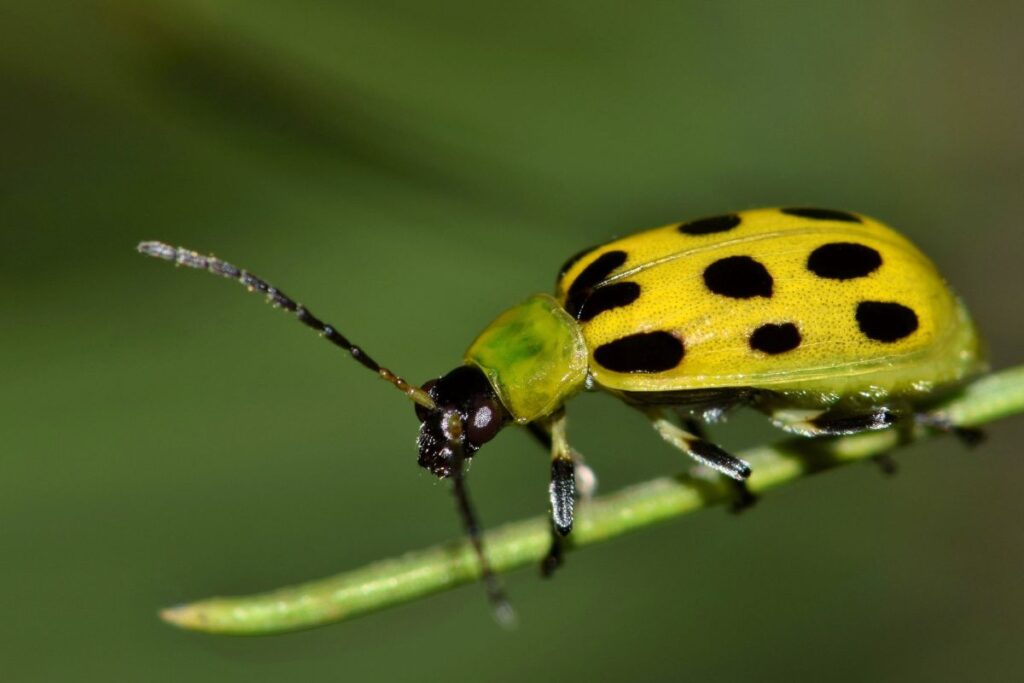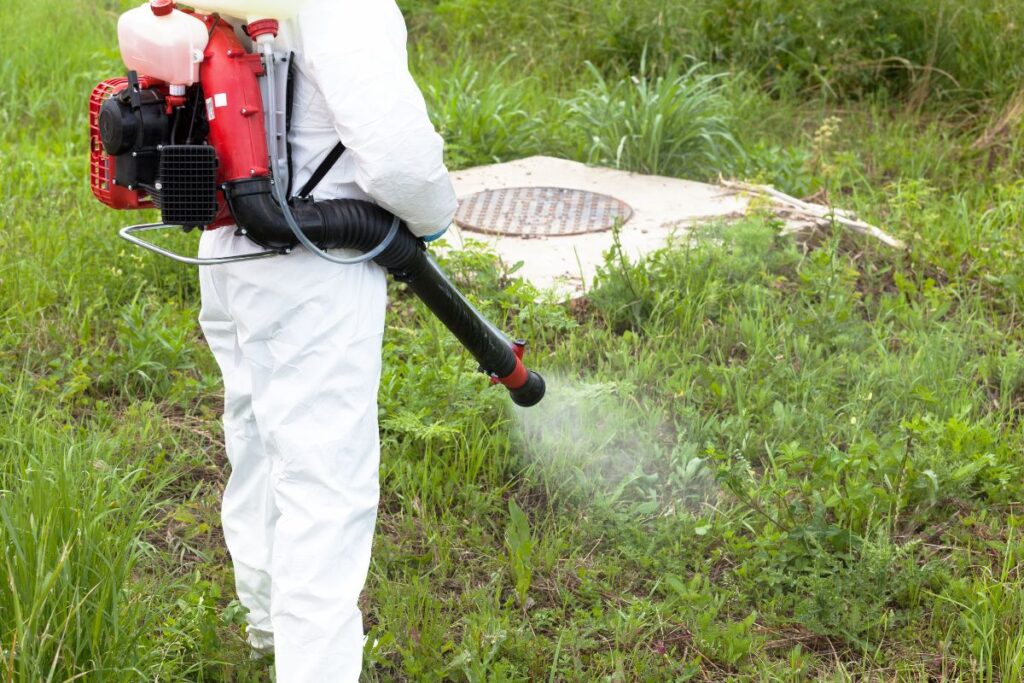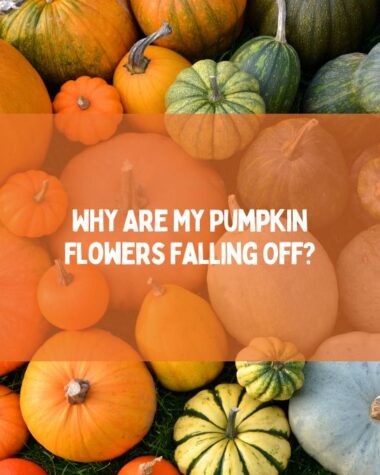Welcome, pumpkin enthusiasts! Growing your own pumpkin patch can be as rewarding as it is challenging. Just when you think you’ve conquered the art of nurturing these charming gourds, unexpected pests make themselves at home in your patch, threatening to undo all your hard work.
Fortunately, our comprehensive guide to identifying and treating common pumpkin pests has covered you. I’ll explore everything from natural remedies to integrated pest management strategies that will help protect and preserve your precious pumpkins.
Common Pumpkin Pests And How To Identify Them
Squash bugs, cucumber beetles, aphids, vine borers, and powdery mildew are among the most common pumpkin pests that can wreak havoc on your pumpkin patch if left unaddressed.
Squash Bugs

Squash bugs can be a nightmare for pumpkin growers, as these pests are notorious for their voracious appetite and the damage they inflict on plants. They primarily target leaves, causing them to wilt and turn brown in a short period of time.
Identifying squash bugs early on is crucial to protecting your pumpkin patch effectively. Adult squash bugs resemble brown or gray stink bugs and have an elongated body shape, while their smaller nymphs vary from light green to gray with distinctive spindly legs.
Keep an eye out for evidence of an infestation, such as tiny clusters of reddish-brown eggs underneath leaves or around plant stems.
Cucumber Beetles

Cucumber beetles are common pests that can cause significant damage to pumpkins. These tiny, yellow-green insects have black spots on their wings and feed on the leaves, stems, and fruits of pumpkins.
Besides feeding on the plants themselves, cucumber beetles can also transmit bacterial wilt disease, which causes wilting and the eventual death of the plant.
One effective way to control cucumber beetles is through companion planting. Planting radishes or marigolds near your pumpkin patch can repel these pests with their strong scents.
Additionally, using row covers during early growth stages can prevent cucumber beetles from laying eggs near your plants.
Aphids

Aphids are a common pest that can cause significant damage to pumpkin plants. These tiny insects suck the sap from plant tissues, leading to stunted growth and yellowing leaves.
To treat aphids naturally, you can use a strong spray of water to knock them off the plant or introduce beneficial insects like ladybugs or lacewings that feed on aphids.
Some gardeners also use homemade garlic or chili pepper sprays as a deterrent. Chemical options include insecticidal soaps or neem oil, which have mild effects on the environment and non-target organisms but should still be used with care.
Related Reading:
- Diseases of Pumpkin Plants: Identification, Treatment, and Prevention Strategies
- How to Prevent Animals from Eating Your Pumpkins?
- How To Keep Bugs Off Pumpkin Plants?
- How To Grow Pumpkins – A Step-by-step Guide
Vine Borers

Vine borers are the larvae of clear-winged moths that typically lay their eggs at the base of pumpkin vines. The larvae burrow into the vine as they hatch and feed on its interior.
One telltale sign of a vine borer infestation is sawdust-like frass around the base of your plants. You may also notice wilted leaves or stems and holes in your vines. Unfortunately, once you see these signs, it’s likely too late to save infected plants.
Treating And Preventing Pumpkin Pests
To effectively manage pumpkin pests, there are various treatment options available. These treatments include natural remedies like using essential oils and garlic spray, chemical treatments like systemic insecticides, and companion planting with pest-repelling plants like marigolds and nasturtiums.
Also, physical barriers and beneficial insects such as ladybugs and lacewings, practicing integrated pest management techniques are also included in treating and preventing pumpkin pests.
Natural Remedies
One effective way to treat pumpkin pests is by using natural remedies. Here’s a list of some of the best:
- Neem oil: This natural insecticide works by disrupting the feeding and mating behaviors of insects, making it an effective pest control option for pumpkins.
- Garlic spray: Create a garlic spray by mashing fresh garlic cloves, straining the pulp, and diluting it with water. Spray this mixture on pumpkin plants to repel pests.
- Insect-repelling plants: Companion planting with herbs such as basil and marigold can help deter pests from attacking your pumpkins.
- Diatomaceous earth: A natural powder that can be sprinkled around pumpkin plants to create a barrier against crawling insects.
- Soap spray: Mix liquid soap (not detergent) with water and spray directly on pumpkin leaves to kill aphids and other soft-bodied insects.
- Hot pepper wax spray: Made from hot peppers, this spray is a great organic option for deterring pumpkin pests while also protecting against fungal diseases.
- Beneficial nematodes: These microscopic organisms are predators that feed on soil-dwelling insects such as grubs and beetles that can damage pumpkin roots.
By incorporating these natural remedies into your pest management strategy, you’ll be able to keep your pumpkin patch healthy without relying on harsh chemicals or pesticides.
Chemical Treatments

Chemical treatments can be an effective way to control pumpkin pests, but they should only be used as a last resort. Here are some common chemical treatments:
- Insecticides: These chemicals kill or repel insects that feed on pumpkins. They come in different forms, including sprays and dust. Some commonly used insecticides for pumpkin pests include pyrethrins, neonicotinoids, and carbaryl.
- Fungicides: These chemicals prevent or treat fungal diseases that can damage pumpkin plants. They come in sprays or powders and are applied directly to the plants. Commonly used fungicides for pumpkin diseases include copper-based products, sulfur-based products, and chlorothalonil.
- Systemic pesticides: These chemicals are taken up by the plant and protect it from pests and diseases from the inside out. They can be applied as a soil drench or injected into the plant’s stem or leaves.
Remember to read labels carefully before using any chemical treatments and follow all instructions for safe use. When using any pesticide, wear protective clothing and avoid spraying on windy days to prevent accidental exposure to yourself or others.
Companion Planting
Companion planting is the practice of strategically planting different crops together in order to repel pests, attract beneficial insects, and improve soil quality.
Here are some examples of companion plants to keep pumpkin pests at bay:
- Marigolds: These beautiful flowers have a scent that repels many pumpkin pests, such as cucumber beetles and squash bugs.
- Nasturtiums: The leaves and flowers of nasturtium plants attract aphids away from the pumpkins, keeping them healthy.
- Radishes: Planting radishes next to your pumpkins can help repel squash vine borers because they dislike the smell of radishes.
- Mint: This herb can be planted near pumpkins to deter cutworms and other pests. It also attracts bees, which help with pollination.
By using these companion plants, you can create a natural barrier around your pumpkin patch that will help keep pests at bay. Plus, it’s an easy way to add some variety and color to your garden while improving soil health!
Physical Barriers
Physical barriers can be an effective way to protect your pumpkin patch from common pests. Here are some options:
- Row covers: Use lightweight fabric covers to physically block pests from getting to your pumpkin plants. These covers can be placed directly over the plants and secured with stakes or other weights.
- Netting: Choose a fine netting material that will prevent insects like cucumber beetles and squash bugs from accessing your pumpkin plants.
- Fencing: Install a fence around your pumpkin patch to keep larger animals like deer and rabbits from damaging the plants.
- Sticky traps: Hang sticky yellow traps around the perimeter of your pumpkin patch to catch flying insects like aphids and whiteflies before they can reach the plants.
Remember, physical barriers are just one component of an integrated pest management strategy. Be sure to combine them with other techniques like natural remedies, companion planting, and regular scouting to stay on top of any pest problems in your pumpkin patch.
Integrated Pest Management
Integrated pest management (IPM) is a holistic approach to managing pests that integrates multiple strategies for prevention, monitoring, and control. It combines biological, cultural, physical, and chemical methods to minimize the negative impacts of pests on pumpkin crops while minimizing harm to the environment.
- For example, one strategy in IPM is crop rotation – switching between different plant families each growing season can help disrupt the life cycles of pests that infect pumpkins year after year.
- Another strategy is biological control, – introducing natural enemies like parasitic wasps or ladybugs to prey on pumpkin pests like aphids or spider mites.
The ultimate goal of integrated pest management is to reduce pesticide application by prioritizing non-chemical means where possible and only using pesticides if absolutely necessary.
Related Reading:
- 5 Reasons Why Zucchini Blossoms Fall Off: A Comprehensive Guide
- 5 Most Common Tomato Stem Problems: And How to Fix Them
- 18 Common Aubergine Growing Problems and Their Solutions
- Troubleshooting Carrot Growing Problems: Why Won’t My Carrots Develop?
- Cucumber Worms: How to Identify, Control, and Prevent Them
Conclusion
In conclusion, early detection and proactive management of pumpkin pests are crucial to ensure a healthy and bountiful harvest. Regular scouting and monitoring techniques help identify pest damage or signs of infestation, allowing for swift action to prevent further spread.
Utilizing preventative measures such as companion planting or physical barriers can also aid in deterring common pumpkin pests. Additionally, implementing integrated pest management strategies like crop rotation and proper watering practices can mitigate the risk of an infestation altogether.







